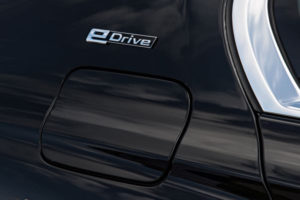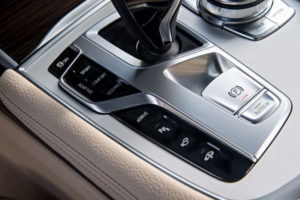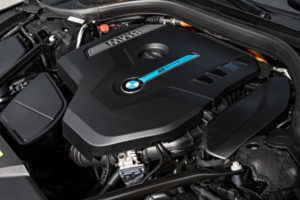
BMW USA continues to roll out plug-in options to more models. Earning a place in the company’s “iPerformance” lineup later this month is the 740e xDrive iPerformance. The 740e will be the first 7 Series to gain a plug and the fifth BMW plug-in overall (including the all-electric i3 with optional range extender). Other plug-in hybrids include the 330e and X5 xDrive40e, and the i8 supercar.
The 740e will carry a lithium-ion battery with a gross capacity of 9.2 kWh and net capacity of 6.5 kWh. 
The battery, which is custom-designed to fit under the rear seat to enhance safety and avoid taking up valuable storage space in the trunk, will provide an all-electric range (according to EPA official figures) of 14 miles; combined gasoline/electric fuel economy is 64 MPGe. This means a lot of around-town driving can be done without using any gasoline at all. If you do take the 740e out onto the highway in all-electric mode, expect to enjoy 111 hp and 184 lb-ft of torque. Maximum all-electric speed is 75 mph.
You can also set the 740e to combine its electric and gasoline capabilities. Doing so will produce a system output of up to 322 hp and combined peak torque of up to 369 lb-ft. Zero to 60 mph is 5.1 seconds, and the top speed is electronically limited to 155 mph.

AUTO eDRIVE, which is automatically activated when the vehicle starts up, is designed to dynamically determine the optimal combination of the combustion engine and electric motor to provide the best possible effect in terms of both efficiency and dynamics. To minimize tailpipe emissions in local driving, AUTO eDRIVE defaults to all-electric mode at low and moderate speeds. In this mode, the combustion engine only joins in at a speed of 50 mph or under heavy throttle applications.
MAX eDRIVE would be used by a driver wishing to drive in all-electric mode. With this setting, the combustion engine will remain off unless the accelerator is floored.
The Battery Control setting is a very interesting feature of the 740e. Battery Control offers the ability to *prevent* the vehicle’s usage of the battery, forcing the use of the combustion engine while maintaining a battery charge level of between 30 and 100 percent. The purpose of holding back (or even increasing) stored electric energy, for example while on the highway when electric mileage is poor compared to electric mileage at slow speeds, is so that the stored electric energy can be deployed later in a journey for efficient and tailpipe-emission-free driving on local roads.
Recognizing the importance of not only fuel economy but also a vehicle’s overall greenhouse potential, BMW estimates that the eDrive technology incorporated into the 740e, which is tailored specifically for this vehicle, results in greenhouse potential (CO2e) being approximately 30 percent lower than that of the gasoline powered 740i over the full lifecycle of the car.

COMFORT mode provides a smoothly balanced overall set-up with the lowest possible energy consumption.
SPORT mode offers a firmer damper setting, increased accelerator response, sharper gear shift dynamics and direct steering characteristics to maximize dynamic performance. The electric boost function is also increased, as is regenerative braking (referred to by BMW as “energy recuperation”).
ECO PRO mode supports an operating strategy which aims to maximize the car’s electric range. As a result, the electric boost function supplementing the power of the combustion engine is only activated if the accelerator is pressed to the floor. A hybrid-specific coasting function is triggered at speeds between 25 – 100 mph, and as soon as the driver releases the accelerator the combustion engine is switched off. Overall, the car uses a sophisticated approach to energy management to determine which energy-saving or energy-consuming features to use based on factors such as preferred driving style, speed, actual battery level, desired battery level, and distance-to-destination.
Like many other plug-ins, the 740e’s climate control can be activated remotely or based on a timer to pre-cool or pre-heat the passenger cabin while the car is plugged in. The purpose of doing this is to maximize the battery’s stored energy for actual driving.
Finally, the 740e’s xDrive all-wheel capability follows the same concept as the X5 xDrive40e in distributing power permanently to all four wheels in all drive combinations. The goal of xDrive technology is to ensure ideal traction, optimized directional stability, and enhanced agility through corners in all weather and road conditions.
The 2017 BMW 740e xDrive iPerformance is in production now and will arrive at U.S. dealerships in August. The base price will be $89,100 plus $995 destination and handling. An M Sport package, as well as other options, will be available.
I invite you to view my other posts and sign up to receive future posts via email. I also invite you to follow me on LinkedIn and Twitter, and to contact me via my homepage.
